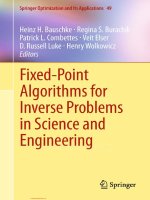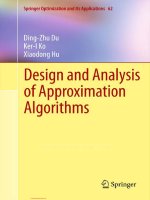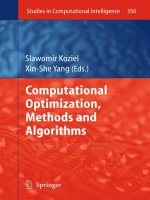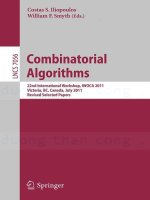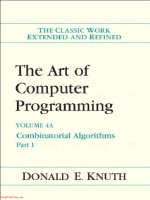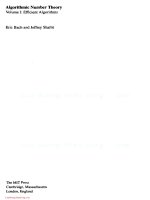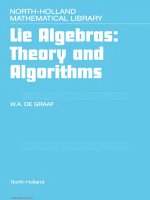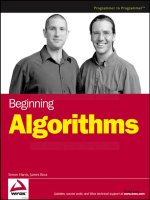euclidean shortest paths exact or approximate algorithms li klette 2011 11 04 Cấu trúc dữ liệu và giải thuật
Bạn đang xem bản rút gọn của tài liệu. Xem và tải ngay bản đầy đủ của tài liệu tại đây (6.68 MB, 395 trang )
CuuDuongThanCong.com
Euclidean Shortest Paths
CuuDuongThanCong.com
“Beauty on the Path”, a digital painting by Stephen Li (Auckland, New Zealand),
September 2011, provided as a gift for this book.
CuuDuongThanCong.com
Fajie Li r Reinhard Klette
Euclidean
Shortest Paths
Exact or Approximate Algorithms
CuuDuongThanCong.com
Fajie Li
School of Information Science
and Technology
Huaqiao University
P.O. Box 800
Xiamen Fujian
People’s Republic of China
Reinhard Klette
Dept. Computer Science
University of Auckland
P.O. Box 92019
Auckland 1142
New Zealand
ISBN 978-1-4471-2255-5
e-ISBN 978-1-4471-2256-2
DOI 10.1007/978-1-4471-2256-2
Springer London Dordrecht Heidelberg New York
British Library Cataloguing in Publication Data
A catalogue record for this book is available from the British Library
Library of Congress Control Number: 2011941219
© Springer-Verlag London Limited 2011
Apart from any fair dealing for the purposes of research or private study, or criticism or review, as permitted under the Copyright, Designs and Patents Act 1988, this publication may only be reproduced,
stored or transmitted, in any form or by any means, with the prior permission in writing of the publishers, or in the case of reprographic reproduction in accordance with the terms of licenses issued by the
Copyright Licensing Agency. Enquiries concerning reproduction outside those terms should be sent to
the publishers.
The use of registered names, trademarks, etc., in this publication does not imply, even in the absence of a
specific statement, that such names are exempt from the relevant laws and regulations and therefore free
for general use.
The publisher makes no representation, express or implied, with regard to the accuracy of the information
contained in this book and cannot accept any legal responsibility or liability for any errors or omissions
that may be made.
Cover design: VTeX UAB, Lithuania
Printed on acid-free paper
Springer is part of Springer Science+Business Media (www.springer.com)
CuuDuongThanCong.com
To Zhixing Li, and to the two youngest in the
Klette family in New Zealand
CuuDuongThanCong.com
CuuDuongThanCong.com
Foreword
The world is continuous the mind is discrete.
David Mumford (born 1937)
Recently, I was confronted with the problem of planning my travel from Israel
to New Zealand, home of the two authors of this book. When taking two antipodal
points on the globe, like Haifa and Queenstown, there is an infinite number of shortest paths connecting these points. Still, due to constraints like reachable airports and
airlines, finding the optimal solution was almost immediate.
Throughout the long history of geometry sciences, the problem of finding the
shortest path in various scenarios occupied the minds of researchers in many fields.
Even in Euclidean spaces, which are considered simple, the introduction of obstacles leads to challenging problems for which efficient computational solvers are hard
to find. The optimal path in 3D space with polyhedral obstacles was among the first
geometric problems proven to be, at least formally, computationally hard to solve. It
took almost 20 years for a team of 5 programming experts to eventually implement
a method approximating the continuous Dijkstra algorithm that is reviewed in this
book. Exact problems are hard to solve, and approximations are obviously required.
My personal line of work when dealing with geometric problems somewhat differs from the school of thought promoted by this book. A numerical approximation
in my vocabulary involves the notion of accuracy that depends on an underlying grid
resolution. This grid is defined by sampling the domain of the problem and leads to
the field of numerical geometry in which efficient solvers are simple to design.
The alternative computational geometry school of thought describes obstacles
as polyhedral structures that allegedly define the “exact” problem. The resulting
challenges under this setting are extremely difficult to overcome. Still, the unifying
bridge between these two philosophical branches is defined by the geometric problems. Without being familiar with the difficulty involved in designing a path between
points in a weighted domain, one could not appreciate the conceptual simplicity of
numerical Eikonal solvers.
This book addresses the type of hard problems in the computational geometry
flavor while inventing constraints that allow for efficient solvers to be designed. For
example, the creative rubberband methods explored in this book restrict the optimal
vii
CuuDuongThanCong.com
viii
Foreword
paths to bands of bounded width, thereby redefining problems and simplifying the
challenges, proving yet again Aleksandr Pushkin’s observation that “inspiration is
needed in geometry, just as much as in poetry.” I hope that, like me, the reader
would find the geometrical challenges introduced in this book fascinating and also
appreciate the elegance of the proposed solutions.
Haifa, Israel
CuuDuongThanCong.com
Ron Kimmel
Preface
A Euclidean shortest path connects a source with a destination, avoids some places
(called obstacles), visits some places (called attractions), possibly in a defined order, and is of minimum length. Euclidean shortest-path problems are defined in the
Euclidean plane or in Euclidean 3-dimensional space. The calculation of a convex
hull in the plane is an example for finding a shortest path (around the given set
of planar obstacles). Polyhedral obstacles and polyhedral attractions, a start and an
endpoint define a general Euclidean shortest-path problem in 3-dimensional space.
The book presents selected algorithms (i.e., not aiming at a general overview)
for the exact or approximate solution of shortest-path problems. Subjects in the
first chapters of the book also include fundamental algorithms. Graph theory offers
shortest-path algorithms for discrete problems. Convex hulls (and to a lesser extent
also constrained convex hulls) have been discussed in computational geometry. Seidel’s triangulation and Chazelle’s triangulation method for a simple polygon, and
Mitchell’s solution of the continuous Dijkstra problem have also been selected for a
detailed presentation, just to name three examples of important work in the area.
The book also covers a class of algorithms (called rubberband algorithms),
which originated from a proposal for calculating minimum-length polygonal curves
in cube-curves; Thomas Bülow was a co-author of the initiating publication, and he
coined the name ‘rubberband algorithm’ in 2000 for the first time for this approach.
Subsequent work between 2000 and now shows that the basic ideas of this algorithm generalised for solving a range of problems. In a sequence of publications
between 2003 and 2010, we, the authors of this book, describe a class of rubberband
algorithms with proofs of their correctness and time-efficiency. Those algorithms
can be used to solve different Euclidean shortest-path (ESP) problems, such as calculating the ESP inside of a simple cube-arc (the initial problem), inside of a simple
polygon, on the surface of a convex polytope, or inside of a simple polyhedron, but
also ESP problems such as touring a finite sequence of polygons, cutting parts, or
the safari, zookeeper, or watchman route problems.
We aimed at writing a book that might be useful for a second or third-year algorithms course at the university level. It should also contain sufficient details for
students and researchers in the field who are keen to understand the correctness
ix
CuuDuongThanCong.com
x
Preface
proofs, the analysis of time complexities and related topics, and not just the algorithms and their pseudocodes. The book discusses selected subjects and algorithms
at some depth, including mathematical proofs for most of the given statements. (This
is different from books which aim at a representative coverage of areas in algorithm
design.)
Each chapter closes with theoretical or programming exercises, giving students
various opportunities to learn the subject by solving problems or doing their own
experiments. Tasks are (intentionally) only sketched in the given programming exercises, not described exactly in all their details (say, as it is typically when a costumer
specifies a problem to an IT consultant), and identical solutions to such vaguely described projects do not exist, leaving space for the creativity of the student.
The audience for the book could be students in computer science, IT, mathematics, or engineering at a university, or academics being involved in research or teaching of efficient algorithms. The book could also be useful for programmers, mathematicians, or engineers which have to deal with shortest-path problems in practical
applications, such as in robotics (e.g., when programming an industrial robot), in
routing (i.e., when selecting a path in a network), in gene technology (e.g., when
studying structures of genes), or in game programming (e.g., when optimising paths
for moves of players)—just to cite four of such application areas.
The authors thank (in alphabetical order) Tetsuo Asano, Donald Bailey, Chanderjit Bajaj, Partha Bhowmick, Alfred (Freddy) Bruckstein, Thomas Bülow, Xia Chen,
Yewang Chen, David Coeurjolly, Eduardo Destefanis, Michael J. Dinneen, David
Eppstein, Claudia Esteves Jaramillo, David Gauld, Jean-Bernard Hayet, David
Kirkpatrick, Wladimir Kovalevski, Norbert Krüger, Jacques-Olivier Lachaud, Joe
Mitchell, Akira Nakamura, Xiuxia Pan, Henrik G. Petersen, Nicolai Petkov, Fridrich
Sloboda, Gerald Sommer, Mutsuhiro Terauchi, Ivan Reilly, the late Azriel Rosenfeld, the late Klaus Voss, Jinlong Wang, and Joviša Žuni´c for discussions or comments that were of relevance for this book.
The authors thank Chengle Huang (ChingLok Wong) for discussions on rubberband algorithms; he also wrote C++ programs for testing Algorithms 7 and 8. We
thank Jinling Zhang and Xinbo Fu for improving C++ programs for testing Algorithm 7. The authors acknowledge computer support by Wei Chen, Wenze Chen,
Yongqian Du, Wenxian Jiang, Yanmin Luo, Shujuan Peng, Huijuan Pi, Huazhen
Wang, and Jian Yu.
The first author thanks dean Weibin Chen at Huaqiao University for supporting
the project of writing this book. The second author thanks José L. Marroquín at
CIMAT Guanajuato for an invitation to this institute, thus providing excellent conditions for working on this book project.
Parts of Chap. 4 (on relative convex hulls) are co-authored by Gisela Klette, who
also contributed comments, ideas and criticisms throughout the book project.
We are grateful to Garry Tee for corrections and valuable comments, often adding
important mathematical or historic details.
Huaqiao, People’s Republic of China
Auckland, New Zealand
CuuDuongThanCong.com
Fajie Li
Reinhard Klette
Contents
Part I
Discrete or Continuous Shortest Paths
1
Euclidean Shortest Paths . . . . . . . . . . . . . . . . . .
1.1 Arithmetic Algorithms . . . . . . . . . . . . . . . . .
1.2 Upper Time Bounds . . . . . . . . . . . . . . . . . .
1.3 Free Parameters in Algorithms . . . . . . . . . . . .
1.4 An Unsolvable Problem . . . . . . . . . . . . . . . .
1.5 Distance, Metric, and Length of a Path . . . . . . . .
1.6 A Walk in Ancient Alexandria . . . . . . . . . . . . .
1.7 Shortest Paths in Weighted Graphs . . . . . . . . . .
1.8 Points, Polygons, and Polyhedra in Euclidean Spaces
1.9 Euclidean Shortest Paths . . . . . . . . . . . . . . . .
1.10 Problems . . . . . . . . . . . . . . . . . . . . . . . .
1.11 Notes . . . . . . . . . . . . . . . . . . . . . . . . . .
References . . . . . . . . . . . . . . . . . . . . . . .
.
.
.
.
.
.
.
.
.
.
.
.
.
.
.
.
.
.
.
.
.
.
.
.
.
.
.
.
.
.
.
.
.
.
.
.
.
.
.
.
.
.
.
.
.
.
.
.
.
.
.
.
.
.
.
.
.
.
.
.
.
.
.
.
.
.
.
.
.
.
.
.
.
.
.
.
.
.
.
.
.
.
.
.
.
.
.
.
.
.
.
3
3
5
6
7
9
12
15
19
23
26
27
29
2
Deltas and Epsilons . . . . . . . . . . . . . . . . . . . . . . . .
2.1 Exact and δ-Approximate Algorithms . . . . . . . . . . . .
2.2 Approximate Iterative ESP Algorithms . . . . . . . . . . .
2.3 Convergence Criteria . . . . . . . . . . . . . . . . . . . .
2.4 Convex Functions . . . . . . . . . . . . . . . . . . . . . .
2.5 Topology in Euclidean Spaces . . . . . . . . . . . . . . . .
2.6 Continuous and Differentiable Functions; Length of a Curve
2.7 Calculating a Zero of a Continuous Function . . . . . . . .
2.8 Cauchy’s Mean-Value Theorem . . . . . . . . . . . . . . .
2.9 Problems . . . . . . . . . . . . . . . . . . . . . . . . . . .
2.10 Notes . . . . . . . . . . . . . . . . . . . . . . . . . . . . .
References . . . . . . . . . . . . . . . . . . . . . . . . . .
.
.
.
.
.
.
.
.
.
.
.
.
.
.
.
.
.
.
.
.
.
.
.
.
.
.
.
.
.
.
.
.
.
.
.
.
.
.
.
.
.
.
.
.
.
.
.
.
31
31
34
36
39
40
43
45
47
48
49
50
3
Rubberband Algorithms . . . . . . . . . . . . . . . . . . . . . . . . .
3.1 Pursuit Paths . . . . . . . . . . . . . . . . . . . . . . . . . . . . .
3.2 Fixed or Floating ESP Problems; Sequence of Line Segments . . .
53
53
56
xi
CuuDuongThanCong.com
xii
Contents
3.3
3.4
3.5
3.6
3.7
3.8
3.9
3.10
3.11
3.12
Part II
Rubberband Algorithms . . . . . . . . . . . . . . . . . .
A Rubberband Algorithm for Line Segments in 3D Space
Asymptotic and Experimental Time Complexity . . . . .
Proof of Correctness . . . . . . . . . . . . . . . . . . . .
Processing Non-disjoint Line Segments as Inputs . . . . .
More Experimental Studies . . . . . . . . . . . . . . . .
An Interesting Input Example of Segments in 3D Space .
A Generic Rubberband Algorithm . . . . . . . . . . . . .
Problems . . . . . . . . . . . . . . . . . . . . . . . . . .
Notes . . . . . . . . . . . . . . . . . . . . . . . . . . . .
References . . . . . . . . . . . . . . . . . . . . . . . . .
.
.
.
.
.
.
.
.
.
.
.
.
.
.
.
.
.
.
.
.
.
.
.
.
.
.
.
.
.
.
.
.
.
.
.
.
.
.
.
.
.
.
.
.
.
.
.
.
.
.
.
.
.
.
.
57
59
60
63
69
72
74
75
85
88
88
.
.
.
.
.
.
.
.
.
.
.
Paths in the Plane
4
Convex Hulls in the Plane . . . . . . . . . . . . .
4.1 Convex Sets . . . . . . . . . . . . . . . . . .
4.2 Convex Hull and Shortest Path; Area . . . . .
4.3 Convex Hull of a Set of Points in the Plane . .
4.4 Convex Hull of a Simple Polygon or Polyline .
4.5 Relative Convex Hulls . . . . . . . . . . . . .
4.6 Minimum-Length Polygons in Digital Pictures
4.7 Relative Convex Hulls—The General Case . .
4.8 Problems . . . . . . . . . . . . . . . . . . . .
4.9 Notes . . . . . . . . . . . . . . . . . . . . . .
References . . . . . . . . . . . . . . . . . . .
.
.
.
.
.
.
.
.
.
.
.
.
.
.
.
.
.
.
.
.
.
.
.
.
.
.
.
.
.
.
.
.
.
.
.
.
.
.
.
.
.
.
.
.
93
93
96
100
105
111
113
114
121
123
124
5
Partitioning a Polygon or the Plane . . . . . . . . . . . . . . . .
5.1 Partitioning and Shape Complexity . . . . . . . . . . . . . .
5.2 Partitioning of Simple Polygons and Dual Graphs . . . . . .
5.3 Seidel’s Algorithm for Polygon Trapezoidation . . . . . . . .
5.4 Inner, Up-, Down-, or Monotone Polygons . . . . . . . . . .
5.5 Trapezoidation of a Polygon at Up- or Down-Stable Vertices .
5.6 Time Complexity of Algorithm 20 . . . . . . . . . . . . . .
5.7 Polygon Trapezoidation Method by Chazelle . . . . . . . . .
5.8 The Continuous Dijkstra Problem . . . . . . . . . . . . . . .
5.9 Wavelets and Shortest-Path Maps . . . . . . . . . . . . . . .
5.10 Mitchell’s Algorithm . . . . . . . . . . . . . . . . . . . . . .
5.11 Problems . . . . . . . . . . . . . . . . . . . . . . . . . . . .
5.12 Notes . . . . . . . . . . . . . . . . . . . . . . . . . . . . . .
References . . . . . . . . . . . . . . . . . . . . . . . . . . .
.
.
.
.
.
.
.
.
.
.
.
.
.
.
.
.
.
.
.
.
.
.
.
.
.
.
.
.
.
.
.
.
.
.
.
.
.
.
.
.
.
.
127
127
129
132
139
142
151
154
156
157
160
167
168
169
6
ESPs in Simple Polygons . . . . . . . . . . .
6.1 Properties of ESPs in Simple Polygons .
6.2 Decompositions and Approximate ESPs
6.3 Chazelle Algorithm . . . . . . . . . . .
6.4 Two Approximate Algorithms . . . . . .
6.5 Chazelle Algorithm Versus Both RBAs .
.
.
.
.
.
.
.
.
.
.
.
.
.
.
.
.
.
.
171
171
174
177
177
180
CuuDuongThanCong.com
.
.
.
.
.
.
.
.
.
.
.
.
.
.
.
.
.
.
.
.
.
.
.
.
.
.
.
.
.
.
.
.
.
.
.
.
.
.
.
.
.
.
.
.
.
.
.
.
.
.
.
.
.
.
.
.
.
.
.
.
.
.
.
.
.
.
.
.
.
.
.
.
.
.
.
.
.
.
.
.
.
.
.
.
.
.
.
.
.
.
.
.
.
.
.
.
.
.
.
.
.
.
.
.
.
.
.
.
.
.
.
.
.
.
.
.
.
.
.
.
.
.
.
.
.
.
.
.
.
.
.
.
Contents
xiii
6.6 Turning the Approximate RBA into an Exact Algorithm
6.7 Problems . . . . . . . . . . . . . . . . . . . . . . . . .
6.8 Notes . . . . . . . . . . . . . . . . . . . . . . . . . . .
References . . . . . . . . . . . . . . . . . . . . . . . .
.
.
.
.
.
.
.
.
.
.
.
.
.
.
.
.
.
.
.
.
.
.
.
.
183
183
186
186
7
Paths on Surfaces . . . . . . . . . . . . . . . . . . . . . . . .
7.1 Obstacle Avoidance Paths in 3D Space . . . . . . . . . .
7.2 Polygonal Cuts and Bands . . . . . . . . . . . . . . . . .
7.3 ESPs on Surfaces of Convex Polyhedrons . . . . . . . . .
7.4 ESPs on Surfaces of Polyhedrons . . . . . . . . . . . . .
7.5 The Non-existence of Exact Algorithms for Surface ESPs
7.6 Problems . . . . . . . . . . . . . . . . . . . . . . . . . .
7.7 Notes . . . . . . . . . . . . . . . . . . . . . . . . . . . .
References . . . . . . . . . . . . . . . . . . . . . . . . .
.
.
.
.
.
.
.
.
.
.
.
.
.
.
.
.
.
.
.
.
.
.
.
.
.
.
.
.
.
.
.
.
.
.
.
.
.
.
.
.
.
.
.
.
.
191
191
193
195
200
206
207
208
210
8
Paths in Simple Polyhedrons . . . . . . . . . . . . . . . .
8.1 Types of Polyhedrons; Strips . . . . . . . . . . . . .
8.2 ESP Computation . . . . . . . . . . . . . . . . . . .
8.3 Time Complexity . . . . . . . . . . . . . . . . . . .
8.4 Examples: Three NP-Complete or NP-Hard Problems
8.5 Conclusions for the General 3D ESP Problem . . . .
8.6 Problems . . . . . . . . . . . . . . . . . . . . . . . .
8.7 Notes . . . . . . . . . . . . . . . . . . . . . . . . . .
References . . . . . . . . . . . . . . . . . . . . . . .
.
.
.
.
.
.
.
.
.
.
.
.
.
.
.
.
.
.
.
.
.
.
.
.
.
.
.
.
.
.
.
.
.
.
.
.
.
.
.
.
.
.
.
.
.
.
.
.
.
.
.
.
.
.
.
.
.
.
.
.
.
.
.
213
213
218
222
224
226
226
227
229
9
Paths in Cube-Curves . . . . . . . . . . . . . . . . . . . .
9.1 The Cuboidal World . . . . . . . . . . . . . . . . . . .
9.2 Original and Revised RBA for Cube-Curves . . . . . .
9.3 An Algorithm with Guaranteed Error Limit . . . . . . .
9.4 MLPs of Decomposable Simple Cube-Curves . . . . .
9.5 Analysis of the Original RBA . . . . . . . . . . . . . .
9.6 RBAs for MLP Calculation in Any Simple Cube-Curve
9.7 Correctness Proof . . . . . . . . . . . . . . . . . . . .
9.8 Time Complexities and Examples . . . . . . . . . . . .
9.9 The Non-existence of Exact Solutions . . . . . . . . . .
9.10 Problems . . . . . . . . . . . . . . . . . . . . . . . . .
9.11 Notes . . . . . . . . . . . . . . . . . . . . . . . . . . .
References . . . . . . . . . . . . . . . . . . . . . . . .
.
.
.
.
.
.
.
.
.
.
.
.
.
.
.
.
.
.
.
.
.
.
.
.
.
.
.
.
.
.
.
.
.
.
.
.
.
.
.
.
.
.
.
.
.
.
.
.
.
.
.
.
.
.
.
.
.
.
.
.
.
.
.
.
.
.
.
.
.
.
.
.
.
.
.
.
.
.
231
231
236
238
243
257
274
284
287
290
303
304
307
.
.
.
.
.
.
.
.
.
.
.
.
.
.
.
.
.
.
.
.
.
.
.
.
313
313
315
317
Part III Paths in 3-Dimensional Space
Part IV Art Galleries
10 Touring Polygons . . . . . . . . .
10.1 About TPP . . . . . . . . . .
10.2 Contributions in This Chapter
10.3 The Algorithms . . . . . . .
CuuDuongThanCong.com
.
.
.
.
.
.
.
.
.
.
.
.
.
.
.
.
.
.
.
.
.
.
.
.
.
.
.
.
.
.
.
.
.
.
.
.
.
.
.
.
.
.
.
.
.
.
.
.
.
.
.
.
.
.
.
.
xiv
Contents
10.4
10.5
10.6
10.7
Experimental Results . . . . . . . . .
Concluding Remarks and Future Work
Problems . . . . . . . . . . . . . . . .
Notes . . . . . . . . . . . . . . . . . .
References . . . . . . . . . . . . . . .
.
.
.
.
.
.
.
.
.
.
.
.
.
.
.
.
.
.
.
.
.
.
.
.
.
.
.
.
.
.
.
.
.
.
.
.
.
.
.
.
.
.
.
.
.
.
.
.
.
.
.
.
.
.
.
.
.
.
.
.
.
.
.
.
.
.
.
.
.
.
.
.
.
.
.
321
322
323
324
325
.
.
.
.
.
.
.
.
.
.
.
.
.
.
.
.
.
.
.
.
.
.
.
.
.
.
.
.
.
.
.
.
.
.
.
.
.
.
.
.
.
.
.
.
.
.
.
.
.
.
.
.
.
.
.
.
.
.
.
.
.
.
.
.
.
.
.
.
.
.
.
.
.
.
.
.
.
.
.
.
.
.
.
.
.
.
.
.
.
.
.
.
.
.
.
.
.
.
.
.
.
.
.
.
.
.
.
.
.
.
.
.
327
327
333
336
342
343
343
12 Safari and Zookeeper Problems . . . . . .
12.1 Fixed and Floating Problems; Dilations
12.2 Solving the Safari Route Problem . . .
12.3 Solving the Zookeeper Route Problem
12.4 Some Generalisations . . . . . . . . .
12.5 Problems . . . . . . . . . . . . . . . .
12.6 Notes . . . . . . . . . . . . . . . . . .
References . . . . . . . . . . . . . . .
.
.
.
.
.
.
.
.
.
.
.
.
.
.
.
.
.
.
.
.
.
.
.
.
.
.
.
.
.
.
.
.
.
.
.
.
.
.
.
.
.
.
.
.
.
.
.
.
.
.
.
.
.
.
.
.
.
.
.
.
.
.
.
.
.
.
.
.
.
.
.
.
.
.
.
.
.
.
.
.
.
.
.
.
.
.
.
.
.
.
.
.
.
.
.
.
.
.
.
.
.
.
.
.
.
.
.
.
.
.
.
.
.
.
.
.
.
.
.
.
347
347
350
353
355
359
360
361
Appendix Mathematical Details .
A.1 Derivatives for Example 9.6
A.2 GAP Inputs and Outputs . .
A.3 Matrices Q for Sect. 9.9 . .
.
.
.
.
.
.
.
.
.
.
.
.
.
.
.
.
.
.
.
.
.
.
.
.
.
.
.
.
.
.
.
.
.
.
.
.
.
.
.
.
.
.
.
.
.
.
.
.
.
.
.
.
.
.
.
.
.
.
.
.
363
363
364
366
11 Watchman Routes . . . . . . . . . . .
11.1 Essential Cuts . . . . . . . . . . .
11.2 Algorithms . . . . . . . . . . . . .
11.3 Correctness and Time Complexity .
11.4 Problems . . . . . . . . . . . . . .
11.5 Notes . . . . . . . . . . . . . . . .
References . . . . . . . . . . . . .
.
.
.
.
.
.
.
.
.
.
.
.
.
.
.
.
.
.
.
.
.
.
.
.
.
.
.
.
.
.
.
Index . . . . . . . . . . . . . . . . . . . . . . . . . . . . . . . . . . . . . . 371
CuuDuongThanCong.com
Abbreviations
Definitions
2D
3D
AMLPP
CAV
CH
ESP
iff
MLA
MLP
MLPP
MPP
RBA
RCH
SPM
SRP
TPP
WRP
ZRP
Symbols
|S|
∂S
∧
∨
∩
∪
pq
pqr
2-dimensional
3-dimensional
Approximate minimum-length pseudo-polygon; see page 276
Cavity; see page 98
Convex hull; see page 97
Euclidean shortest path; see page 11
Read: if and only if; see page 6
Minimum-length arc; see page 279
Minimum-length polygon; see page 114, 231–233, 304
Minimum-length pseudo-polygon; see page 275
Minimum-perimeter polygon; see page 111
Rubberband algorithm; see page 58
Relative convex hull; see page 121
Shortest path map; see page 159
Safari route problem; see page 349
Touring polygon problem; see page 313
Watchman route problem; see page 327
Zookeeper route problem; see page 349
Cardinality of set S
Relation sign for being parallel
Frontier of set S
Logical ‘and’
Logical ‘or’
Intersection of sets
Union of sets
Straight line segment with endpoints p and q
Triangle with vertices p, q, and r
Trapezoid or triangle (in a partitioning)
xv
CuuDuongThanCong.com
xvi
Abbreviations
pq
(pqr)
Straight line defined by points p and q; orientation “from p to q”
Angle formed by rotating segment pq clockwise into segment qr
End of a proof or of an example
a, b, c
A(·)
α, β
C
dm
de
D
δ
e
E
ε
εs
f, g, h
g
g
F
F
G
G
γ
Real numbers
Area of a measurable set (as a function)
Angles
√
Set of complex numbers a + i · b, with i = −1 and a, b ∈ R
Minkowski metrics, for m = 1, 2, . . . or m = ∞
Euclidean metric; note that de = d2
Determinant; see page 96
Real number greater than zero
Edge (e.g., of a graph); real constant e = exp(1) ≈ 2.7182818284
Set of edges of a graph
Real number greater than zero (the accuracy of an RBA)
Real number greater than zero (a shift distance)
Functions, for example from N into R
Simple cube-curve
Tube (i.e., the union of cubes) of a simple cube-curve g
Face of a polyhedron
Set of faces of a polyhedron
Graph
Set {. . . , −2, −1, 0, 1, 2, . . .} of integers
Curve in Euclidean space (e.g., straight line, polyline, smooth curve)
H
i, j, k, l, m, n
i
j
k
κ
L
L(·)
l(ρ)
λ
n
N
N
O(·)
p, q
p(x)
p.x, pi .x
p.y, pi .y
p.z, pi .z
P
Half plane; see page 95
Natural numbers
Number of iterations, e.g., in a rubberband algorithm
Natural number; index of points or vertices in a path
Natural number; total number of items
Function in ε
Length (as a real number)
Length of a rectifiable curve (as a function)
Length of a path ρ
Real number; e.g., between 0 and 1
Natural number; e.g., defining the complexity of the input
Neighbourhood (in the Euclidean topology, or in grids)
Set {0, 1, 2, . . .} of natural numbers
Asymptotic upper time bound
Points in R2 or R3 , with coordinates xp , yp , or zp
Polynomial in x
x-coordinate of point p or point pi
y-coordinate of point p or point pi
z-coordinate of point p or point pi
Polygon
CuuDuongThanCong.com
Abbreviations
P •, P ◦
π
xvii
Closure and topological interior of polygon P
Plane in R3 ; real constant π = 4 × arctan(1) ≈ 3.14159265358979
Polyhedron
•, ◦
Closure and topological interior of polyhedron
k
Product of sets Si
i=1 Si
P
Partitioning (of the plane or of a simple polygon)
r
Radius of a disk or sphere; point in R2 or R3
R
Set of real numbers
ρ
Path with finite number of vertices; see page 11
s
Point in R2 or R3
S, Si
Sets
S
Family of sets
t
Point in R2 or R3
T
Tree; threshold (a real number)
τ
Threshold (real number)
T
Trapezoidation or triangulation (of the plane or of a simple polygon)
v
Vertex or node; a point in R2 or R3 , with coordinates xv , yv , or zv
V
Set of vertices of a graph
V (G), V (T ) Set of vertices of graph G or tree T
V (ρ)
Set of vertices of a path ρ
→
vu, −
vu
Undirected or directed line segment between points v and u
x
Real variable
x
Vector
y
Real variable
y
Vector
Z
Set of integers
CuuDuongThanCong.com
CuuDuongThanCong.com
Part I
Discrete or Continuous Shortest Paths
The road system of the historic city of Guanajuato is mostly underground, forming
a network of tunnels. Optimising routes from one part of the city to another part is
an exciting task not only for visitors of the city, but even for locals. In 2010, there
was not yet a “3D route planner” available for calculating shortest connections in
this historic city.
The first part of the book defines shortest paths in the geometry that we practise in our daily life, known as Euclidean geometry. Finding a shortest path
between two given points and avoiding existing obstacles can be a challenge.
We provide basic definitions and we propose the class of rubberband algorithms for solving various Euclidean shortest-path problems, either defined in
the plane or in the 3-dimensional space.
CuuDuongThanCong.com
CuuDuongThanCong.com
Chapter 1
Euclidean Shortest Paths
Ptolemy once asked Euclid whether there was any shorter way
to a knowledge of geometry than by a study of the Elements,
whereupon Euclid answered that there was no royal road to
geometry.
Proclus Diadochus (410. . . 412–485)
This introductory chapter explains the difference between shortest paths in finite
graphs and shortest paths in Euclidean geometry, which is also called ‘the common
geometry of our world’. The chapter demonstrates the diversity of such problems,
defined between points in a plane, on a surface, or in the 3-dimensional space.
1.1 Arithmetic Algorithms
Technology is evaluated by applying various measures, which are mapping components of the technology into real numbers, such as kilometres per hour, a maximum
error in millimetres, or a shape descriptor. We describe algorithms with respect to
run time, deviations of results from being optimal, or necessary constraints on input
data.
The shortest path algorithms in this book are designed to be fast, accurate,
and for a wide range of input data.
The time for calculating a shortest path on a computer depends on parameters
such as available memory space or execution time per applied operation. It is meaningless to express the required time as an absolute value in, say, micro- or nanoseconds, because computers differ in their parameters, they change frequently, and
your computer is certainly not identical to the one used by someone else.
F. Li, R. Klette, Euclidean Shortest Paths,
DOI 10.1007/978-1-4471-2256-2_1, © Springer-Verlag London Limited 2011
CuuDuongThanCong.com
3
4
1
Euclidean Shortest Paths
Measures for computing time need to be independent from the configuration of
computers for expressing the quality of an algorithm. For example, we apply an abstract measure to estimate the running time of algorithms, also called time complexity or computational complexity. This is a common approach in computer science
for more than 50 years. We define a set of basic operations, thus specifying a particular abstract computer, and we assign one time unit to each basic operation. Such
a ‘unit of time’ is not measured in a physical scale; it is an abstract unit for each
basic operation. For those abstract units, the estimation of run time of an algorithm
is independent of progress in computer technology.
Definition 1.1 An algorithm is a finite sequence of basic operations.
We consider basic operations that are executable on ‘a normal sequential computer’, and not, for example, on some kind of specialised processor. Basic operations are classified into numerical operations, logical tests, and control instructions;
alphanumerical operations on letters or other symbols are not a subject in this book.
Logical tests are comparisons in magnitude (such as “length < threshold”?). Control instructions are of the type if-then-else, while-do, or do-until. It only remains to
define a particular computer model by specifying the set of numerical operations.
Definition 1.2 An arithmetic algorithm is defined by having addition, subtraction,
multiplication, division, and the nth root (for any integer n > 1) as its basic operations.
A scientific algorithm expands an arithmetic algorithm by the following additional basic operations: trigonometric and inverse trigonometric functions, exponential and logarithmic functions, factorials, and conversions of numbers between
different representation schemes (binary, decimal, or hexadecimal).
This book applies arithmetic algorithms for solving shortest-path problems.
(There is just one case in the book where trigonometric functions are used when
optimising a point location in an ellipse.)
Arithmetic algorithms are further specified by the range of numbers they are
working on. For example, assuming the unbounded range of rational numbers a/b
(for integers a and b) goes beyond the capabilities of existing computers, which can
only represent rational numbers up to some finite number of bits per number. Even
if divisions a/b are not performed, and assuming that there are no roots (i.e., all
calculations remain in the area of integers) then there is still the problem of a limited
range, having only a finite number of bits for representing all available integers.
Definition 1.3 An arithmetic algorithm over the rational numbers uses the basic
operations as available in an arithmetic algorithm and operates on the set of all
rational numbers.
CuuDuongThanCong.com
1.2 Upper Time Bounds
5
1.2 Upper Time Bounds
We assume, as is common in algorithmic complexity theory, that the performance
of each basic operation requires one time unit.
Consider functions f and g, defined on the set N = {0, 1, 2, . . .} of natural numbers and into the set of non-negative reals; the input parameter n ≥ 0 stands for the
problem size, such as, for example, the number n = |S| of points in an input set S.
The book applies asymptotic upper time bounds O(f (n)) for characterising
the run time of an algorithm.
Definition 1.4 O(f (n)) is the class of all functions g with
g(n) ≤ c · f (n)
for some asymptotic constant c > 0 and all n ≥ n0 , for some n0 ≥ 0.
Example 1.1 This example is an exercise on the given upper bound. Most of the
time complexities considered in this book are polynomial, but we also include higher
complexities in this example. Let
g1 (n) = 5n + 10,
g2 (n) = 5n log10 n + 1,000n,
3
g3 (n) = n3 + 5,000n2 ,
7
g4 (n) = 3n! + 100n100 ,
n2
g5 (n) = 100
+ 100n4 ,
25
1
g6 (n) = 2n + 5,000n2 .
2
Recall that
√
n n
(Stirling’s formula)
e
with π = 4 × arctan(1) ≈ 3.14159265 and e = exp(1) ≈ 2.7182818284. Furthermore,
n! = n(n − 1)(n − 2) · · · 1 ∼
n2
25
=
2πn
n2 (n2 − 1) · · · (n2 − 24)
25!
denotes a binomial coefficient.
It follows that the given six functions are all in the class O(nn+1/2 ). We also say
that they are upper bounded by nn+1/2 . Except for the function g4 , the other five
functions are all in the exponential class O(2n ). The functions g1 , g2 , g3 , and g5
are upper bounded by the polynomial bound n50 . The functions g1 , g2 , and g3 are
in O(n3 ). Finally, the functions g1 and g2 are in O(n log n), and the function g1 is
of linear complexity.
CuuDuongThanCong.com
6
1
Euclidean Shortest Paths
1.3 Free Parameters in Algorithms
Finite sets of free parameters, such as an upper limit for the number of loops or
an approximation parameter ε > 0, specify many of the algorithms in this book.
For instance, a shortest path needs to stay at a distance of at least ε from given
obstacles, such that every object with a maximum diameter of 2ε can still move on
the calculated path.
Free parameters may influence the time complexity of an algorithm. We illustrate
by an example before we provide general statements.
Example 1.2 We need to specify the smallest positive integer m for n positive numbers a1 , a2 , . . . , an and a free parameter ε > 0 such that at least one ai /m is smaller
than ε > 0; we need to return a1 /m, a2 /m, . . . , an /m, for the identified value of m.
The free parameter ε is initialised when calling a solution to this task.
Brute-force principle: Systematically check all possible candidates whether
they define a solution.
A brute-force algorithm is as follows: We divide all those n numbers by m =
1, 2, 3, 4, . . . in sequence, until at least one of the values ai /m is smaller than ε > 0;
we stop and return a1 /m, a2 /m, . . . , an /m.
What is the asymptotic time complexity of this brute-force algorithm? Obviously,
each iteration for one m-value takes linear time, because all n values are divided
and tested. The number of iterations equals m0 , where m0 is the final value of m.
an
} = min{a1 , a2 , . . . , an }/m0 . Thus, the upper
It follows that ε ≈ min{ ma10 , ma20 , . . . , m
0
bound for the time complexity of this algorithm may also be expressed in the form
m0 · O(n).
Definition 1.5 We call an algorithm κ-linear iff1 its time complexity is κ(ε) · O(n),
and the function κ does not depend on the problem size n.
The brute-force algorithm is κ-linear; the function κ is here defined by dividing
the minimum of all ai by ε.
An obvious way for speeding up would be an algorithm based on the
Throw-away principle: Remove ‘quickly’ all the input data from any further
processing which does not have any influence on the outcome of a process.
1 Read
“if and only if”; abbreviation proposed by Paul Richard Halmos (1916–2006).
CuuDuongThanCong.com
